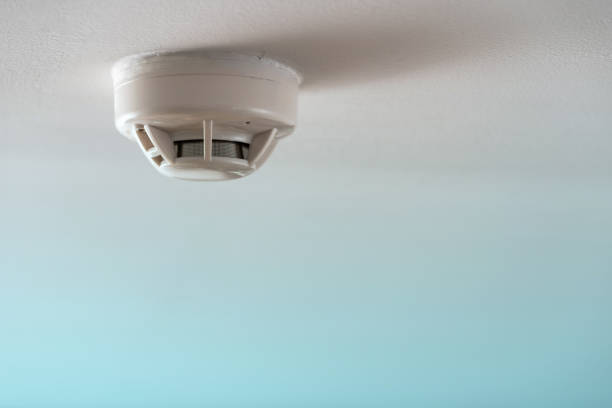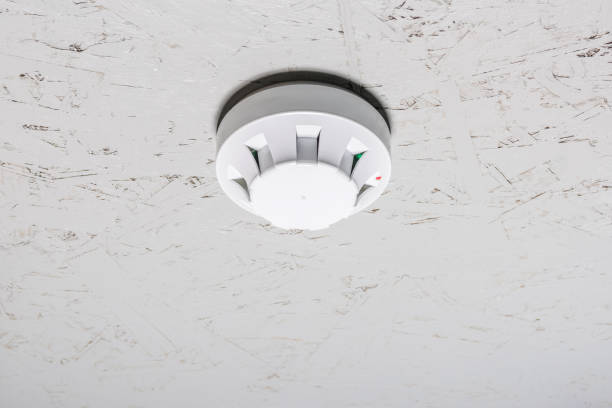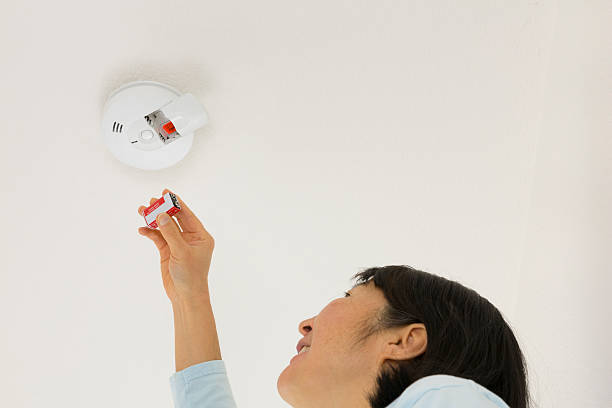Last Updated: April 2025
Discover the reasons behind those annoying smoke detector beeps and learn how to fix them quickly with our comprehensive troubleshooting guide.
Understanding Why Your Smoke Detector Is Beeping
That persistent beeping from your smoke detector can drive anyone crazy, especially when it starts in the middle of the night. If you’re wondering “why is my smoke detector beeping,” you’re not alone. This common household frustration affects millions of homeowners every year, but understanding the causes can help you resolve the issue quickly and ensure your home remains safe.
Smoke detectors are vital safety devices designed to alert you to potential fire hazards. When functioning properly, they provide early warning that can save lives and property. However, these devices are programmed to alert you not only to fire dangers but also to their own maintenance needs through different beeping patterns.
In this comprehensive guide, we’ll explore why your smoke detector is beeping, how to interpret different alarm sounds, and provide practical solutions to silence those annoying chirps while maintaining your home’s safety.

Common Reasons Why Your Smoke Detector Is Beeping
Low Battery Power
The most common reason why smoke detectors beep is low battery power. According to fire safety experts, approximately 80% of smoke detector beeping issues are related to battery problems. When batteries reach a certain voltage threshold, the detector is designed to emit a warning chirp.
How to identify: If your smoke detector is beeping with a single chirp every 30-60 seconds, this typically indicates a low battery situation.
Solution: Replace the batteries with fresh ones. Most smoke detectors use 9-volt batteries, while some newer models may use AA or AAA batteries. Always check your specific model’s requirements. After replacing the battery, press and hold the test button to ensure the detector is functioning properly.
Pro Tip: Mark the date on your calendar when you replace the batteries. Most manufacturers recommend changing smoke detector batteries twice a year. A good rule of thumb is to change them when you adjust your clocks for daylight saving time.

End of Life Warning
Smoke detectors don’t last forever. Most have a lifespan of 7-10 years, after which the sensing technology becomes less reliable. Manufacturers program these devices to alert you when they’ve reached the end of their useful life.
How to identify: If your smoke detector continues to chirp even after you’ve replaced the batteries, or if it makes a different pattern of beeps than the standard low-battery warning, it may be signaling that it’s reached the end of its life cycle.
Solution: Check the manufacturing date on your smoke detector (usually printed on the back or inside the unit). If it’s older than 10 years, it’s time for a replacement. Modern smoke detectors offer improved technology and enhanced safety features compared to older models.
You can find quality replacement options in our smoke detector comparison guide or at retailers like Home Depot or Amazon.
Dust and Debris Buildup
Over time, dust, pet hair, and other airborne particles can accumulate within your smoke detector, interfering with its sensors and potentially causing false alarms or intermittent beeping.
How to identify: If your smoke detector beeps inconsistently or triggers false alarms when there’s no sign of smoke, dust buildup might be the culprit.
Solution: Clean your smoke detector regularly. Here’s how:
- Turn off power to hardwired units or remove the battery from battery-operated models
- Gently vacuum the exterior vents using a soft brush attachment
- Wipe the cover with a slightly damp cloth
- Allow it to dry completely before restoring power or reinserting the battery
Regular cleaning not only prevents false alarms but also ensures your detector will work properly when you need it most. Most manufacturers recommend cleaning smoke detectors every six months.
Temperature and Humidity Fluctuations
Smoke detectors are surprisingly sensitive to environmental changes. Significant fluctuations in temperature or humidity can cause your smoke detector to beep unexpectedly.
How to identify: If your smoke detector tends to beep during specific weather conditions or at certain times of the day when temperature changes occur, environmental factors may be triggering the alarm.
Solution: Consider relocating your smoke detector if it’s installed in an area prone to temperature swings or high humidity. Ideal locations include:
- Central hallways
- Living rooms
- Bedrooms
- Stairwells
Avoid installing smoke detectors near windows, doors, air vents, bathrooms, or kitchens where environmental conditions fluctuate dramatically.
Regional Climate Considerations
| Climate Region | Common Issues | Recommendations |
|---|---|---|
| Hot, Humid Southeast | High humidity triggering false alarms | Use humidity-resistant models; maintain AC during summer |
| Cold Northeast/Midwest | Battery voltage drops in winter | Replace batteries in fall before temperature drops |
| Dry Southwest | Dust accumulation in detectors | More frequent cleaning (quarterly) |
| Pacific Northwest | Condensation from rain/humidity | Install detectors away from exterior walls |
| Variable Climate Areas | Seasonal temperature swings | Opt for thermally stable placement locations |
Improper Placement
The location of your smoke detector plays a crucial role in its performance. Improper placement can lead to false alarms and unnecessary beeping.
How to identify: If your smoke detector frequently beeps when cooking, showering, or using appliances that generate steam or heat, the placement may be inappropriate.
Solution: Reposition your smoke detectors following these guidelines:
- Install at least 10 feet away from cooking appliances
- Keep away from bathrooms and laundry rooms
- Place at least 3 feet from air vents, windows, and doors
- Mount on ceilings or high on walls (smoke rises)
- Avoid uninsulated areas like garages where temperature extremes occur
For comprehensive placement recommendations, visit the National Fire Protection Association website.

Understanding Different Smoke Detector Beeping Patterns
Smoke detectors communicate through specific beeping patterns. Learning to interpret these sounds can help you respond appropriately to different situations.
Smoke Detector Alert Patterns Quick Reference
| Beeping Pattern | Meaning | Required Action |
|---|---|---|
| Continuous 3 beeps (BEEP-BEEP-BEEP, pause, repeat) | Smoke detected | Evacuate immediately, call 911 |
| 4 beeps, pause, repeat (BEEP-BEEP-BEEP-BEEP, pause) | Carbon monoxide detected | Evacuate immediately, call 911 |
| Single chirp every 30-60 seconds | Low battery | Replace batteries |
| Chirp every 30 seconds that continues after battery replacement | End of life warning | Replace entire detector |
| Intermittent random chirps | Dust/interference/malfunction | Clean or replace detector |
| Short beep when pressing test button | Normal test function | No action (test monthly) |
Continuous Loud Beeping
What it means: A continuous series of three loud beeps (BEEP-BEEP-BEEP with slight pauses) indicates that the detector has sensed smoke or a potential fire.
What to do:
- Evacuate all occupants immediately
- Call emergency services (911)
- Do not re-enter the building until authorized by emergency personnel
This is the most serious alert and requires immediate action. Remember, your safety is the priority.
Single Chirp Every 30-60 Seconds
What it means: As discussed earlier, this pattern typically indicates a low battery.
What to do: Replace the batteries promptly. Ignoring this warning could leave your home unprotected from fire hazards.
Four Beeps Followed by a Pause
What it means: A pattern of four beeps followed by a pause (BEEP-BEEP-BEEP-BEEP, pause) indicates the presence of carbon monoxide (CO) in combination smoke/CO detectors.
What to do:
- Evacuate immediately
- Call emergency services
- Do not return until the property has been cleared by professionals
Carbon monoxide is particularly dangerous because it’s colorless and odorless. Learn more about carbon monoxide safety at the CDC’s carbon monoxide information page.
Chirping That Continues After Battery Replacement
What it means: If chirping continues despite fresh batteries, your detector may have reached its end of life or have a technical malfunction.
What to do: Replace the entire unit. For hardwired detectors, you may need to consult an electrician if the problem persists after replacement.
Troubleshooting Why Your Smoke Detector Is Beeping
Let’s go through a systematic approach to troubleshooting your beeping smoke detector:
Quick Troubleshooting Flowchart
Step 1: Identify the Type of Smoke Detector
Before attempting any fixes, determine whether you have:
- Battery-operated detectors
- Hardwired detectors with battery backup
- Interconnected detector system
- Smart smoke detectors
Each type may have different troubleshooting procedures.
Step 2: Check and Replace the Batteries
As mentioned earlier, this is the most common solution. Even hardwired detectors have backup batteries that need regular replacement.
For hardwired systems, follow these steps:
- Turn off power at the circuit breaker
- Remove the detector from its mounting bracket
- Open the battery compartment
- Replace with fresh batteries of the recommended type
- Restore power and test the detector
Learn more about maintaining hardwired smoke detection systems in our complete alarm troubleshooting guide.
Step 3: Clean the Detector
If new batteries don’t solve the problem, dust and debris might be the culprit. Follow the cleaning instructions provided earlier in this article.
Step 4: Check for Interference
Look for potential sources of interference near your smoke detector:
- Fluorescent lighting
- Electronic devices
- HVAC vents
- Cooking appliances
- High humidity areas
Try relocating the detector away from these potential interference sources.
Step 5: Reset the Detector
Many smoke detectors have a reset function:
- Remove the batteries
- Press and hold the test button for 15-20 seconds
- Insert fresh batteries
- Test the detector
This process clears the detector’s memory and can resolve persistent beeping in some cases.
Step 6: Replace the Unit
If all else fails, it’s time for a replacement. When purchasing a new smoke detector, consider:
- Dual-sensor models (both ionization and photoelectric)
- Units with sealed 10-year batteries
- Smart detectors that connect to your home automation system
- Interconnected systems that activate all alarms when one detects smoke
Why Your Smoke Detector Might Be Beeping at Night
Have you noticed that your smoke detector often starts beeping during the night? This common phenomenon has several explanations:
- Temperature drops: Nighttime temperature decreases can affect battery voltage, triggering the low-battery warning.
- Reduced background noise: The quiet nighttime environment makes even soft chirps more noticeable.
- Battery depletion timing: Batteries often reach their critical threshold after being in use for several hours during the day.
- Humidity changes: In many regions, humidity levels fluctuate between day and night, potentially affecting detector sensors.
To prevent middle-of-the-night disruptions, proactively replace batteries at regular intervals rather than waiting for the warning chirps to begin.
False Alarms: Why Your Smoke Detector Is Beeping Without Fire
False alarms can be annoying and potentially dangerous if they lead to “alarm fatigue” where you begin ignoring alerts. Here are common causes of false alarms and how to address them:
Cooking Smoke and Steam
Problem: Kitchen activities generate smoke, steam, and aerosols that can trigger nearby detectors.
Solution: Install heat detectors rather than smoke detectors in kitchens, or use smoke detectors specifically designed for kitchen environments with reduced sensitivity or temporary silencing features.
Shower Steam
Problem: Steam from hot showers can mimic smoke particles and trigger alarms.
Solution: Keep bathroom doors closed when showering and use bathroom exhaust fans. Consider relocating detectors at least 10 feet from bathroom doors.
Dust During Renovation
Problem: Construction or renovation work creates dust that can enter detector sensors.
Solution: Temporarily cover smoke detectors with manufacturer-approved covers during renovation work. Remember to remove the covers immediately after work is completed.
Insects Inside the Detector
Problem: Small insects can enter the sensing chamber and trigger false alarms.
Solution: Use compressed air to gently blow out any potential insect intruders. Some manufacturers also sell insect screens for their detectors.
Learn more about preventing false alarms at The U.S. Fire Administration.
Hard-Wired Smoke Detector Beeping Issues
Hardwired smoke detectors present unique challenges when they start beeping. Here’s what you need to know:
Power Supply Problems
Problem: Electrical issues can cause intermittent beeping even with functioning backup batteries.
Solution: Check your electrical panel for tripped breakers. For persistent issues, consult a licensed electrician to inspect the wiring.
Interconnected System Complications
Problem: In interconnected systems, one malfunctioning detector can cause all units to chirp.
Solution: Systematically check each detector in the system to identify the problematic unit. Replace that unit if necessary.
Circuit Board Failure
Problem: Electronic components can fail over time, causing beeping or false alarms.
Solution: This typically requires replacement of the entire detector. Most circuit boards are not user-serviceable.
For more detailed information about resolving persistent beeping in interconnected systems, visit our detailed guide on solving complex alarm issues.
Smart Smoke Detector Beeping Problems
Modern smart smoke detectors offer additional features but can also present unique troubleshooting challenges:
Connectivity Issues
Problem: Poor WiFi connections can cause smart detectors to chirp or display error messages on connected apps.
Solution: Check your network connection and ensure the detector is within range of your router. Some models may need to be reset and reconnected to your network.
Software Updates
Problem: Pending software updates can occasionally cause alert beeps.
Solution: Check the manufacturer’s app to ensure your device’s firmware is current. Most smart detectors update automatically, but manual intervention may sometimes be necessary.
Battery Depletion Despite Hardwiring
Problem: Many smart detectors use both hardwiring and batteries, and the backup battery can still deplete.
Solution: Replace batteries according to the manufacturer’s schedule, typically annually or when prompted by the app.
Mobile Integration Tips
Most smart smoke detectors now offer mobile app integration for real-time monitoring and remote alerts. Here are some tips to optimize your smart detector experience:
- Enable push notifications to receive alerts even when away from home
- Connect your smoke detector to other smart home devices for automated responses (like turning on lights during an alarm)
- Set up guest access for trusted neighbors or family members who can respond during emergencies
- Regularly update the app to ensure compatibility with detector firmware updates
Top-Rated Smoke Detectors for Different Needs
If you need to replace your beeping smoke detector, here are some highly-rated options for different situations:
Best Overall Smoke Detectors
- Google Nest Protect – Features smartphone alerts, voice announcements, and both smoke and CO detection. Self-tests automatically and connects with other smart home devices.
- First Alert BRK 3120B – Hardwired with battery backup, featuring dual sensors (photoelectric and ionization) for comprehensive protection.
- Kidde P12040 Hardwired – Budget-friendly option with interconnect capability for whole-home protection.
Best for Easy Installation
- First Alert SCO5CN – Battery-operated with both smoke and CO detection, requiring no wiring.
- X-Sense SC01 – Features a 10-year sealed battery eliminating frequent battery changes.
Best for Smart Home Integration
- Ring Alarm Smoke and CO Listener – Works with existing detectors to send alerts to your smartphone.
- Kidde RF-SM-DC – Wireless interconnection without complex wiring.
Remember to check local building codes, as some jurisdictions require specific types of smoke detectors in particular locations.
Maintenance Schedule to Prevent Smoke Detector Beeping
Proactive maintenance is the best way to prevent annoying beeps and ensure your smoke detectors function properly when needed. Follow this recommended schedule:
Monthly Tasks
- Test each smoke detector by pressing the test button
- Listen for a loud, piercing alarm
- If the sound is weak or absent, replace batteries immediately
Semi-Annual Tasks (Every 6 Months)
- Replace batteries in all detectors
- Clean detectors using the method described earlier
- Check manufacturing dates and plan replacements for aging units
Annual Tasks
- Perform a smoke test using an aerosol smoke detector tester
- Check interconnected systems to ensure all detectors activate when one is tested
- Review and update your home evacuation plan
Every 10 Years
- Replace all smoke detectors regardless of apparent functionality
- Consider upgrading to newer technology with enhanced features
- Document installation dates for future reference
Visit our maintenance reminder tool for printable maintenance schedules and calendar integration.

Choosing the Right Replacement When Your Smoke Detector Won’t Stop Beeping
If troubleshooting fails to resolve the beeping, it’s time to select a replacement. Here are important factors to consider:
Comparison of Smoke Detector Types
| Feature | Ionization | Photoelectric | Dual Sensor | Smart Detectors |
|---|---|---|---|---|
| Best for detecting | Fast, flaming fires | Smoldering fires | Both types | Both types with added features |
| False alarm frequency | Higher | Lower | Moderate | Lowest (smart algorithms) |
| Power options | Battery, hardwired | Battery, hardwired | Battery, hardwired | Battery, hardwired, sealed |
| Typical price range | $10-$25 | $15-$30 | $25-$50 | $80-$150 |
| Lifespan | 10 years | 10 years | 10 years | 7-10 years |
| Special features | Basic | Basic | Basic | Remote alerts, self-testing |
| Best placement | Bedrooms, hallways | Kitchens, living rooms | Anywhere | Anywhere |
Power Sources
- Battery-operated: Easiest to install but require regular battery changes.
- Hardwired with battery backup: More reliable but require professional installation if your home isn’t pre-wired.
- 10-year sealed battery: No battery replacement needed for the life of the detector.
Additional Features Worth Considering
- Voice alerts that specify the type and location of danger
- Interconnectivity capability (wired or wireless)
- Silence buttons for easily stopping false alarms
- Carbon monoxide detection
- Smart home integration
Technical Support Resources for Major Brands
If you’ve tried all troubleshooting steps and your smoke detector is still beeping, contacting the manufacturer’s technical support may help:
| Manufacturer | Phone Support | Online Support |
|---|---|---|
| First Alert | 1-800-323-9005 | First Alert Support |
| Kidde | 1-800-880-6788 | Kidde Support |
| Google Nest | 1-855-469-6378 | Nest Support |
| X-Sense | 1-833-978-3606 | X-Sense Support |
| SimpliSafe | 1-888-910-1215 | SimpliSafe Support |
| Ring | 1-800-656-1918 | Ring Support |
Why Is My Smoke Detector Beeping? A Comprehensive Checklist
To summarize our guide, here’s a quick reference checklist to diagnose why your smoke detector is beeping:
- [ ] Check battery voltage and replace if necessary
- [ ] Verify the manufacturing date (replace if older than 10 years)
- [ ] Clean dust and debris from sensing chambers
- [ ] Ensure proper placement away from interference sources
- [ ] Reset the detector following manufacturer instructions
- [ ] Check for humidity and temperature issues
- [ ] Inspect wiring connections (for hardwired models)
- [ ] Update firmware (for smart detectors)
- [ ] Test the detector using the test button
- [ ] Contact the manufacturer if problems persist
Conclusion: Ensuring Safety While Silencing That Annoying Beep
Understanding why your smoke detector is beeping is the first step toward resolving the issue while maintaining your home’s safety. Remember that smoke detectors are designed to alert you not just to fire dangers but also to their own maintenance needs. Those annoying chirps serve an important purpose – ensuring your detector will work when you need it most.
Regular maintenance, prompt battery replacement, and timely unit replacement are small investments that can literally save lives. When troubleshooting why your smoke detector is beeping, always prioritize safety over silence.
Have you had unique experiences with beeping smoke detectors? Share your stories and solutions in the comments below to help other homeowners with similar issues!
For more detailed information about smoke detector maintenance, troubleshooting, and product recommendations, explore our other helpful resources at SmokeDetectorBeeping.com.
FAQs About Why Smoke Detectors Beep
Why is my smoke detector beeping at 3 AM?
Temperature drops during the night can cause battery voltage to fall below the threshold level, triggering the low-battery warning chirp. This commonly happens in the early morning hours when home temperatures are at their lowest.
How long will a smoke detector chirp before the battery dies completely?
Most smoke detectors will chirp for at least 7 days before the battery dies completely. However, you should replace batteries as soon as the chirping begins rather than waiting.
Can I disconnect a beeping smoke detector?
While you can temporarily remove a battery to stop the beeping, you should never leave your home unprotected. Always install fresh batteries or a replacement detector immediately.
Why does my smoke detector beep even after I’ve replaced the batteries?
Persistent beeping after battery replacement could indicate the detector has reached its end of life (typically 10 years), has dust in the sensing chamber, or has a manufacturing defect.
How can I tell if my smoke detector needs replacement or just new batteries?
If your detector continues to chirp after battery replacement, check the manufacturing date. Detectors older than 10 years should be replaced regardless of their apparent condition.
Why is my hardwired smoke detector beeping when there’s no power outage?
Hardwired detectors have backup batteries that can trigger low-battery warnings even when house power is functioning normally. They may also beep due to wiring issues or end-of-life warnings.
Can extreme weather cause my smoke detector to beep?
Yes, significant temperature changes, high humidity, and power fluctuations during storms can all potentially trigger smoke detector beeping or false alarms.
Should I replace all smoke detectors at the same time?
For interconnected systems, replacing all detectors at once ensures compatibility and consistent performance. For independent detectors, replacement should be based on individual manufacturing dates.


发表回复